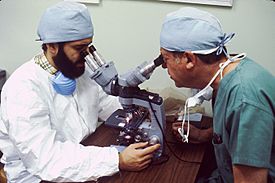Pathology facts for kids

A pathologist examines a tissue section for evidence of cancerous cells while a surgeon observes.
|
|
| Focus | Disease |
|---|---|
| Subdivisions | Anatomical pathology, clinical pathology, dermatopathology, forensic pathology, hematopathology, histopathology, molecular pathology, surgical pathology |
| Significant diseases | All infectious and organic diseases and physiological disorders. |
| Significant tests | All medical diagnostic tests, particular biopsy, blood analysis, dissection, and other applications of medical microscopy |
| Specialist | Pathologist |
Pathology is a special area of medicine. It is all about studying and understanding diseases. Pathologists are like medical detectives. They look very closely at parts of the body to find out what is causing a sickness.
Pathologists use many tools to do their work. They might look at tiny pieces of tissue under a microscope. They also test body fluids, like blood. Sometimes, they perform an autopsy. This is a careful examination of a body after someone has died. It helps them find out why the person died.
Contents
What Pathologists Do
Pathologists are doctors who specialize in finding out what is wrong with a person. They help other doctors make the right diagnosis. A diagnosis is when a doctor figures out what illness a patient has.
How They Study Diseases
Pathologists study diseases in many ways. They often look at cells and tissues. These are the tiny building blocks of your body. They can see if cells are healthy or if they have changed because of a disease.
Looking at Tissues and Cells
One common way pathologists work is by examining biopsy samples. A biopsy is a small piece of tissue taken from a living person. The pathologist prepares this tissue very carefully. They put it on a glass slide and look at it with a powerful microscope. This helps them spot problems like infections or even cancer.
Testing Body Fluids
Pathologists also test different body fluids. This includes blood, urine, and other liquids from the body. These tests can show if there are signs of disease. For example, a blood test can reveal if someone has an infection. It can also show if certain parts of the body are not working right.
The Importance of Pathology
Pathology is very important for healthcare. Pathologists help doctors understand diseases better. Their work leads to better treatments for patients. They are often behind the scenes, but their findings are crucial.
Helping Doctors Diagnose Illnesses
When you go to the doctor, they might order tests. Many of these tests are sent to a pathology lab. The pathologists there analyze the samples. They then send a report back to your doctor. This report helps your doctor decide what kind of treatment you need.
Understanding Disease Causes
Pathologists also study the etiology of diseases. This big word means the cause of a disease. By understanding what causes a disease, scientists can work on ways to prevent it. They can also develop new medicines.
Images for kids
-
The advent of the microscope was one of the major developments in the history of pathology. Here researchers at the Centers for Disease Control in 1978 examine cultures containing Legionella pneumophila, the pathogen responsible for Legionnaires' disease.
-
A bone marrow smear from a case of erythroleukemia. The large cell in the top center is an abnormal erythroblast: it is multinucleated, with megaloblastoid nuclear chromatin This is diagnostic of erythroleukemia.
-
A malignant melanoma can often be suspected from sight, but confirmation of the diagnosis or outright removal requires an excisional biopsy.
-
An instance of diagnosis via histopathology, this high-magnification micrograph of a section of cardiac tissue reveals advanced cardiac amyloidosis. This sample was attained through an autopsy.
-
This coronal cross-section of a brain reveals a significant arteriovenous malformation that occupies much of the parietal lobe.
-
A tobacco plant infected with the tobacco mosaic virus
See also
 In Spanish: Patología para niños
In Spanish: Patología para niños












